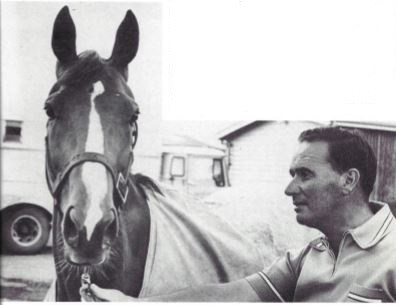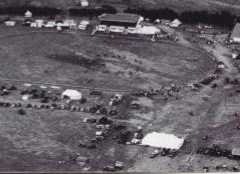13:3
Rugby Park has been the scene of some classic international encoun- ters. Seven Australian teams have played matches there since 1895- Taranaki won two of them; eight British teams have been beaten twice (the 1904 game was a scoreless draw); the Springboks won once and drew twice; France has played twice and the Fijians drew in 1957. All matches were attended by near-capacity crowds. But it was the Ranfurly Shield which perhaps brought most interest (and money) to the town. When the shield was presented by Governor- General Lord Ranfurly in 1902, it was awarded to Auckland as having the best record of that year. It was taken by the first challenger, Wellington, who held it for four challenges until Auckland regained it in 1905. Taranaki made five unsuccessful challenges between 1906 and 1912, but in 1913 the 'log of wood' was brought for the first time to New Plymouth as a result of a 14-12 victory. Six challenges were staved off in 1914 until the shield was lost to Wellington, 12-6. These games were played at New Plymouth, Hawera and Stratford. It was not until 1957 that Peter Burke's team reclaimed the shield from Otago (11-9), and for two seasons, during which 13 matches were played, all at Rugby Park, the trophy remained until Southland won it by 23 to 6.12 Ross Brown's team captured the shield from Wellington in 1963, and for 15 matches and almost three rugby seasons, the roar of Ferdinand was heard in the land until the shield was lost to Auckland, 11-16, in 1965. Ferdinand was a highly improbable savage-looking bull in a striped yellow and black hide-the colours of the province. Before each match he would make the rounds of the city on the back of a truck, bellowing his challenge from electronic apparatus deep in his bowels; he headed processions of decorated floats, trick cyclists and clowns, cheered on by thousands of supporters; and before each match he would bow and dance to the crowd and would charge anyone brave enough to come near him wearing the opponents' colours. Possession of the shield was a euphoric experience for New Plymouth. It also generated business. On Saturdays, when the rest of New Zealand was closed, milk bars and pubs did a roaring trade. Thousands of visitors from the outlying districts and further afield flocked into the city with money in their wallets, a fact which was not regretted by hotel-keepers and shop owners during late Friday shop- ping. From early morning on challenge days special buses would carry spectators from the city centre to the park-this in addition to many hundreds of private cars. Not everyone was fully pleased by Taranaki's possession of the shield.
For each match-and for many international games, too-more than 5 km of roads round the park became free parking areas, and more than one householder's lawn was vandalised by uninvited cars. Westown Primary School allowed parking in its playing area, the proceeds going to school projects. Associated with Rugby Park since it was just one muddy paddock, his voice dominating the Taranaki sporting workd for more than 38 years, was Mark Comber. Between 1949 and 1971 he broadcast commentaries on international, inter-provincial, Ranfurly Shield and club games, as well as conducting regular sporting sessions from Radio Taranaki. In 1979 he recalled some great mornents.!" 'It was near the end of the 1963 season that Taranaki ended Wellington's tenure of the Ranfurly Shield with a 17-3 win-against most predictions. Wanganui challenged, their hopes carried high on the boot of Colin Pierce, who, with four penalty goals, had Wanganui in front, 12-11. With the clock nearing fulltime, Wanganui forced a touch down; Pierce rushed the drop-out from the 25 and the ball landed over the sideline among over-enthusiastic supporters, Referee John Pring ruled "out on the full". From the serum Taranaki's Briscoe worked the blind side to McCullough, Brown, Hurley (who had replaced the injured Roy Johns). Hurley grubber- kicked through, chased and touched down a yard in from the corner for a try-and the winning points. 'The second game for the shield in 1964 was again against Wanganui and their goal-kicking threequarter, Pierce. With only seconds remain- ing Taranaki were leading, J5-12-all Wanganui's points coming from Pierce's boot. Despite the slushy ground, Wanganui decided to run the ball, and Pierce scored in the corner. The clock showed fulltime and the score 15-15. Pierce carefully made a hollow for the ball. I remember commenting: "1 wouldn't be down there in Pierce's place if that hole was full of gold." Twenty thousand Taranaki supporters were absolutely silent. The record book shows that Pierce failed; but what never will be recorded is the sound of the expelled breath from that Taranaki crowd. It was a truly magical moment. Pierce stood dejectedly, perhaps reflecting on his mis-kick in similar circumstances a few months earlier. Now, with a personal contribution of four penalties and a try-15 points-his boot had failed him in his greatest need. 'There were many other thrilling moments during the shield eras, but none so gripping as Colin Pierce's contributions ... ' Not everyone agreed with Comber's assessments. On each match the 30 players-and the referee-were judged on the spot by thousands of 'experts', each returning a, different verdict. It is certain, however, that the Ranfurly Shield matches held the most appeal to Taranaki rugby enthusiasts. The largest Saturday crowd at the park was 37,000 for the match against South Africa in 1965. The biggest weekday attendance was 35,000 to watch the French win, 11-9, in 1961.
The Taranaki Primary Schools' Rugby Union was formed in 1920 to 'organise and control primary schools rugby in the Taranaki Education District' . This, with the Bayly Scholarship founded in 1909 to perpetuate the memory of Alf Bayly, one of Taranaki' s outstanding footballers, has been a great boon to the province's rugby. Many prominent players' careers can be traced to their schooldays when they were given a start in the national game. New Plymouth winners of the scholarship included Ross Brown and Neil Wolfe both of whom later became All Blacks.
Rugby League (usually played at Pukekura Park), soccer (Western Park), hockey, softball and many other sports all have enthusiastic if comparatively small bands of followers. In recent years television, by revealing skills of national and international teams; has aroused new interest, but they are still regarded as 'minor' winter team sports by a city wedded to rugby union. Problems with all these sports stems from insufficient 'away' competition and the fact that finance must be raised by comparatively few followers. Typical is the Taranaki United Association Football Club which in 1978 raised a team to tour New Zealand from the province's five major clubs-and spent $20,000 in doing so. Sunday, June 1, 1975, was a big day for Taranaki soccer: it was the first time Rugby Park had been used by the 'round-ball code' since the game was introduced in the province in 1904; it was the first time a top British team had played in the province, although previous overseas visitors had included Fijians, Canadians and Chinese. A crowd of about 3000 watched Sheffield United beat, as expected, a Taranaki team, 5-nil.
Although New Plymouth has fielded many well-known cricketers, including Alistar Jordan, Henry Sampson, Ted Meuli, Lawrie Miller and Dave Kinsella, even its most ardent supporters will admit this sport has never been in first-class category in the province. New Plymouth has always been the centre of Taranaki cricket. More than 130 years ago a match was played on Poverty Flat. C. W. Richmond wrote to J. Atkinson in Stroud, England, on February 13, 1856: 'The boys have been engaged in a cricket match against the military-the 65th are in New Zealand renowned cricketers and hitherto conquerors wherever they go. They have always beaten the civilians at Wellington. Well-the garrison consisting of the 65th and Lieut Crosse (a fine young fellow from Rugby) and his party of 50 men ofthe 58th, challenged the settlers and "the bush" took up the glove. The betting was 4 to 1 against us ... Military went in first-the bush having won the toss ... Arthur bowling at one end and Smith of Mangorei at the other. The Military soon began to look blue; both bowling and fielding, especially the latter, surprised them. The wickets came rattling down nicely and they went out for 39. It is a pretty sight to see Hal and Teddo as short slip and long stop working together. We then went in and had back luck and not good usage from the umpires ... Ted and Dessy made a fair stand, but Hal was caught out directly . . . He hit to windward, ... but the wind took it into Mr Whitehead's hands. Nevertheless we made 45-thus taking the shine out of the "Hoias" ... Next innings Smith sent out their crack bat, Sergeant Barker, with a "duck egg" ... but Crosse made a score of 22 ... I think they scored 65, leaving the bush 60 to get to win ... it is postponed till next Saturday week ... ' The Richmond-Atkinson Papers, from which this extract was taken, do not reveal the result of the match. Cricket matches were ad hoc affairs: challenges were issued and games took place when men could find the time. Other matches, also on Poverty Flat, were played between men of the Volunteers, the Militia and an Ornata Stockade eleven I 4. Early records are somewhat sketchy, but there was a West End Cricket Club in 1887. President was the Mayor, Arthur Standish, and other officers were J. B. Roy (vice-president), J. C. Davis (club captain), H. J. Honeyfield (deputy-captain) and G. Foote (secretary-treasurer). In March, 1894, the Taranaki Cricket Association was formed with Major Tuke, and later Captain Cornwall, as presidents. In September of that year Taranaki was represented by C. W. Bayly at the formation of the New Zealand Cricket Council in Christchurch, where he was elected a vice-president. Clubs in the Taranaki association included Clifton, Hawera, Star (Hawera), Stratford and United (Opunake). The New Plymouth club, with T. S. Weston as captain and J. F. Stohr as secretary, was formed in October, 1889. Unity was also a town club, and the New Zealand Cricketer's Annual of 1898 listed clubs at Tariki, Waitara, Bell Block and Waireka. In 1903 Lord Hawke's team visited New Plymouth to play Taranaki. The visitors were easy winners, even though Taranaki used 18 batsmen. Lord Hawke presented the Hawke Cup for competition between minor associations in 1910, and Taranaki has held it on three occa- sions-1926-27, 1933-34 and its greatest triumph-from December 1970 to March 1973. Most of the 12 challenge matches were played at Pukekura Park and aroused great public interest. The cup was lost when rain stopped play in the last challenge of the 1972-73 season and Southland held an unassailable lead of 216 runs. Early New Plymouth cricketers of some renown included Robert Clinton Hughes, and Thomas R. Southall. The former, who died at the age of 87 in New Plymouth in 1934, was the last surviving member of the Taranaki Provincial Council. He was a prime mover in acquiring Pukekura Park for the city and held a seat on the park board for more than 50 years. Southall, an accountant, who died in 1949, had served in the Boer War and World War One.

